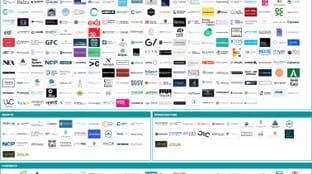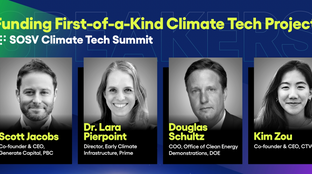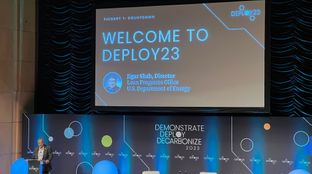
🌏 Who are the Climate Tech Investors?
A new interactive Climate Capital Stack Map
This week we sat down with Albert Wenger, managing partner at Union Square Ventures, who Zoomed in from his “farm of the future” in Hudson Valley, Wally Farms.

This week we sat down with Albert Wenger, managing partner at Union Square Ventures, who Zoomed in from his “farm of the future” in Hudson Valley, Wally Farms. USV invests thematically across big fund theses like “large networks” and “decentralized data.” Recently, they’ve started to develop an adjacent thesis on climate change’s potential to undermine global wellbeing and markets. Accordingly, they announced in November that they’re raising a dedicated $100-$200m climate fund.
How does your personal interest in climate inform your approach to venture investing at USV?
I’ve been writing a book called World After Capital for six years through GitHub. The book argues that we’re 20 years past the Industrial Age because society is no longer held back by a scarcity of capital. Without financial constraint, we can build new machines, buildings, and infrastructure rapidly – if we put our minds to it. What we are lacking is intentionality and attention. The next age, which I call the Knowledge Age, is all about the scarcity of attention. And Exhibit A is the climate crisis. We’re not paying enough attention to it.
A couple of years back, I realized that I was also guilty. It’d be disingenuous to preach about not paying enough attention to the climate crisis without making changes myself. So, I started my journey by reading and writing.
Can you tell us the story about Wally Farms and what it means to you?
I’m actually calling in right now from our farm in upstate New York. We’re trying to farm the future. The question that we’re after is what could land use and farm use look like 20 to 30 years from now? One element is electrifying everything. We have our own microgrid and solar array and we’re about to add battery storage, and have electric vehicles, chainsaws, but sadly not an electric tractor (they’re actually quite hard to come by). Another element is minimizing the amount of land that we use for farming, and maximizing the remainder for biomass and as an animal refuge. Though we’re not vegetarians ourselves, we believe that in 50 to 100 years from now, looking back, future people will be shocked about this age’s extraordinary cruelty to animals at scale, like how we’re agape at the barbarian nature of Middle Age torture. In practice, we’re setting up some indoor container farming that’s powered off a solar array and have an experimental field where we tried to grow willow to convert to biochar. We’re just getting going at Wally Farms and if people want to learn more, we’re building out the website.
What’s USV’s approach to venture investing?
We take a thesis-oriented approach, and we iterate our thesis over time. We are now investing our core fund in companies and projects following what we call “Thesis 3.0” – broadening access to knowledge, capital, and well-being. This includes companies like Duolingo which makes language learning easy and widely available, Stash which makes finance and investing easily accessible via reasonable loans, and Codecademy, Skillshare, and Quizlet. We try to be clear about our thesis and iterate new ideas within that thesis. For example, one of our analysts recently wrote an essay about mental health and how we’re evaluating the next wave of mental health apps.
Over the last 18 months, we also came to a conclusion about our climate change thesis. We started investing in climate startups through our core fund, and soon we will do so out of a dedicated fund.
You invested in Wren and Leap in January. Given all the surprises that 2020 has brought, how has your thinking on climate investing changed since then?
Starting with Leap, we’ve been spending a lot of our time understanding the impacts and opportunities arising from the transition to renewable energy sources – particularly solar and wind. They have two important characteristics that are very different from prior electricity generation – they are: (1) decentralized or distributed, and (2) intermittent. Since Thesis 1 on data, we’ve been interested in networks. Here with Leap, we saw an opportunity to assemble a network of devices acting in aggregate in power markets. Likewise, OhmConnect just announced a huge financing. Each individual home thermostat, charger, and so forth might not feel like it amounts to a lot, but, in aggregate, the network builds rapidly.
With Wren, we believe in the importance of making it easy for people to become aware of their carbon footprint. People are unwilling or unable to change certain things about their life which make it hard to decarbonize. Wren makes it possible for you to compensate for your impact by contributing more trees and planting more biomass – hopefully tilting the balance toward more carbon coming down from the atmosphere than going up. They make that easy, transparent, and fun. There are lots of companies going after this market now – Joro just raised from Sequoia – and it’s important that somebody succeeds. Offsetting isn’t a substitute for also making lifestyle changes, rather this is in addition to making changes.
Are you comfortable betting on a voluntary market for offsets?
Thinking about it from a portfolio construction perspective, we want to design a diversified portfolio where some investments rely on voluntary action with the potential to accelerate from regulation, while others probably only work with regulation. Venture is about making uncorrelated investments – each one of which has a lot of upside under a different scenario. If everything in your portfolio depends on something particular happening, then venture does not work.
What’s your investment framework for thinking about climate tech?
Our high level thesis has three parts: we invest in companies that (1) reduce emissions, (2) draw down existing emissions, or (3) provide adaptation solutions to the climate crisis. That’s at the 50,000-foot level. Then we started developing more specific ideas. Relatively soon, you’ll see us publishing those ideas around EV charging, or software for the grid, or different methods of emissions drawdown.
It’s helpful to have a framework, and we like to express what we’re excited about in our thesis and then have entrepreneurs guide or change it. The process is, of course, iterative – we find companies after publishing these ideas, but also inspire new theses by meeting divergent companies. From a macro perspective, not enough people in the world understand how severe and how imminent the climate crisis really is. We believe that climate change will require a huge amount of human activation to successfully overcome.
This year, for example, with the COVID crisis, the physics of a very small particle spreading through the air is somewhat pernicious. This makes a response complicated, but we have a strong arsenal of ways of dealing with it – including simple solutions like wearing masks through to complex solutions like cloning antibodies and developing fast-tracked vaccines. We should have been better prepared, especially after having two advanced warnings with SARS and MERS.
This contrasts quite starkly with the climate crisis which we’ve known about for a long time and yet are still far behind. Here, the physics are stacked against us pretty dramatically: the amount of energy already in the atmospheric system, particularly in the oceans, is massive.
But, I think more people need to wrap their head around the positive side. There is a huge amount of entrepreneurial activity trying to deal with this on all fronts – from people working on growing biomass faster to capturing carbon through machines. A huge amount of innovation continues to go into electrifying the grid and transport as well as pushing solar cells and batteries further. In the sector as an investor, all of this activity is incredibly encouraging.
This could be humanity’s finest hour. People tend to think of war when referring to “the finest hour,” where it’s humans fighting against humans. This, on the other hand, is humans fighting against an existential crisis that affects everyone. In that way, we either all succeed or fail – which is quite beautiful.
How does the current climate tech wave differ from Cleantech 1.0? How do we “do it right” this time?
We obviously get that question quite a bit from LPs. So much has changed, but I point to four major differences:
🔋 First, the extraordinary progress in solar and battery technologies. People are sort of vaguely aware, but not of the actual amount of progress. In the last decade, both solar and batteries have gotten 10x cheaper. Solar is now the cheapest form of electricity that we can produce today. That’s a very different picture from the clean tech bubble of 2007.
🤔 Next is a big change in attitude. All of the survey data, like from the Yale Climate Project, shows that a majority of people now believe that the climate crisis exists, that it is caused by humans, and that it is dangerous.
🚧 There have also been significant regulatory tailwinds. On the one hand, if you look to DC, you’re like, “Oh, my God! We withdrew from the Paris Accord!” But even during the Trump administration, we’ve seen four or five new states pass a 100%, clean grid 2050 mandate. In other countries, the regulatory push has been much stronger.
💸 Finally, there really was little debt financing available during the Cleantech bubble – meaning much had to be financed by equity. In 2020 alone, there will be $350b of green bonds issued.
When you put all of these factors together, the opportunity today is dramatically different. It’s important to point out that this opportunity exists, to a large degree, because people were willing to invest and take the big bets in cleantech 1.0. It’s easy to be dismissive. But, as the old saying about standing on the shoulders of giants goes, what is happening today is only possible because those bets and because some of them actually worked.
What about corporates’ role in that change?
Absolutely. I put corporates in the attitude change category. When talking about individuals, that includes their impact on corporate perspective changes on climate. Corporates aren’t abstract entities; they’re made up of humans, and more and more humans inside those corporations are realizing the impact of the climate crisis. In tech, there are a bunch of relatively young billionaires who recognize that it’s not going to be great being a billionaire unless we get on top of the climate crisis.
And how about the top down influence of institutional investors seeking ESG alpha?
I am an ESG skeptic – if not, an all out ESG cynic. A lot of funds have the ESG label because it seems to be a way to make fundraising easier. Our climate fund is explicitly not an impact fund and does no ESG reporting.
I have a lot of question markets around ESG grading standards. What’s relevant though is the large generational wealth transfer that’s happening. Many of the people on the receiving end of this wealth transfer recognize the severity of the climate crisis. I think that is very positive and will have an outsized impact on how funds think about where and how they should be investing.
So you will not be doing impact reporting for your climate fund?
That has also been our view for Thesis 3.0. We believe that making knowledge accessible has a huge positive impact on the world. But we’re not trying to measure that belief because impact measurements are often wrong – they try to provide a level of precision but tend to be based on fundamentally unknowable variables. For example, whether certain technologies will be impactful depends on how quickly other technologies get adopted. So much of this analysis is ceteris paribus instead of general equilibrium.
When people ask me more about this, I talk about investing in Twitter. Originally people were confused and uninterested saying, “Why do I care what Jack ate for lunch?” Now, people are fixated on the negative aspects and asking, “How could you ever invest in Twitter? Their algorithms are manipulating the world!” Impact is hard to predict. Our approach at the end of the day is to just be a part of a lot of innovation and watch to see what happens – as opposed to trying to predict over precisely.
Where are the funding gaps for climate?
The biggest funding gap by far is public funding for geoengineering research. And we need a lot of it, fast. We’re very, very far behind and may need to pull the emergency brake on global warming if things really go off the rails. We don’t even have the brake to pull yet, and we need multiple because we’re not sure which is going to work. A lot of people get up in arms about geoengineering and messing with the earth’s systems. But we’re geoengineering right now, and have been in a very uncontrollable fashion for a couple of hundred years. Only we’re making Earth look more like Mars. The other thing that I’d say about geoengineering is that it’s a little bit like chemotherapy; you would never do chemotherapy if you were healthy. But when you have cancer, you would much prefer to have well researched chemo over injecting random chemicals into your body. When you evaluate the amount of money that has gone into geoengineering research collectively and compare it to the threat that we’re facing, it’s a mismatch by many orders of magnitude. We might need aerosols, ocean blooms, you name it on the order of like, three, four, or five years – not in two to three decades. So this requires, in my mind, governments globally to start spending billions as soon as possible. Venture capital will not bridge this massive underfunding gap.
What are your thoughts on hydrogen?
With hydrogen, we’re still coming up the learning curve. But there are a few things that seem clear: (1) we have existing electricity infrastructure already and (2) we have ways of decentralizing electricity generation. Given that, it just seems logical to use batteries and adding a hydrogen step in between would be cumbersome. The question then becomes what are the applications where hydrogen refueling wouldn’t be so much of an issue. Long haul trucking and ocean shipping makes sense, but a wholesale hydrogen economy seems likely – especially when hydrogen is fairly aggressive when combined with oxygen when it escapes.
What are your perspectives on SPACs as a “new” exit option for climate tech companies?
It’s important to first understand why we have SPACs. The number of publicly traded stocks has actually been going down for quite some time, and, coupled with no yield on fixed income, you have this extraordinary supply-demand imbalance with all of this money looking for equities with fewer investable names. The lack of supply is partially due to the process of going public being broken. SPACs offer an opportunity to address this imbalance.
Of course, with a financial innovation like this, you’ll get some people who approach it with rigor and the right mindset, and you get others who are excited to make a quick buck. It happened with crypto and ICOs. I’m not suggesting that any of the SPACs are necessarily downright scams, but you’re getting pretty close to the edges of it.
For climate specifically, the lack of investable names is even greater. Pure climate plays are not easy to come by, so the interest in climate SPACs makes perfect sense. I think that it’ll be net positive in the end, but I anticipate a rocky road and wild ride along the way.
Interested in more content like this? Subscribe to our weekly newsletter on Climate Tech below!

A new interactive Climate Capital Stack Map

Financing around first- or early-of-a-kind project risk

‘Government-enabled, private sector-led’ in action in Washington, DC